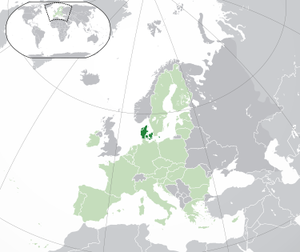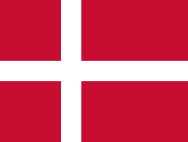Denmark
| Kingdom of Denmark |
|
|
Source information is available at [ Sources ] |
Denmark is a Nordic country in Northern Europe. European Denmark, the southernmost of the Scandinavian countries, consists of a peninsula, Jutland, and an archipelago of 443 named islands, with the largest being Zealand, Funen, and the North Jutlandic Island. The islands are characterized by flat, arable land and sandy coasts, low elevation, and a temperate climate. Denmark lies southwest of Sweden and south of Norway, bordered to the south by Germany. The Kingdom of Denmark is constitutionally a unitary state comprising metropolitan Denmark and the two autonomous territories in the North Atlantic Ocean: the Faroe Islands and Greenland. Denmark has a total area of 42,943 km2 (16,580 sq mi)[Note 1] as of 2020. Metropolitan Denmark has a population of 5.85 million (as of 2021), of which 800,000 live in the capital and largest city, Copenhagen.
History
The unified kingdom of Denmark emerged in the 8th century as a proficient seafaring nation in the struggle for control of the Baltic Sea. Denmark, Sweden, and Norway were ruled by one sovereign ruler in the Kalmar Union, which was established in 1397 and ended with Swedish secession in 1523. The areas of Denmark and Norway remained under the same monarch until 1814, Denmark–Norway. In the 17th century, several devastating wars with the Swedish Empire ended with large cessions of territory to Sweden. After the Napoleonic Wars, Norway was ceded to Sweden, while Denmark kept the Faroe Islands, Greenland, and Iceland. In the 19th century, there was a surge of nationalist movements, which were defeated in the First Schleswig War. After the Second Schleswig War in 1864, Denmark lost the Duchy of Schleswig to Prussia. Denmark remained neutral during World War I; however, in 1920, the northern half of Schleswig became Danish again. In April 1940, a German invasion saw brief military skirmishes, while the Danish resistance movement was active from 1943 until the German surrender in May 1945. An industrialized exporter of agricultural produce in the second half of the 19th century, Denmark introduced social and labor-market reforms in the early 20th century, creating the basis for the present welfare state model with a highly developed mixed economy.
The Constitution of Denmark was signed on 5 June 1849, ending the absolute monarchy, which had begun in 1660. It establishes a constitutional monarchy organized as a parliamentary democracy. The government and national parliament are seated in Copenhagen, the nation's capital, largest city, and main commercial center. Denmark exercises hegemonic influence in the Danish Realm, devolving powers to handle internal affairs. Home rule was established in the Faroe Islands in 1948; in Greenland, home rule was established in 1979, and further autonomy in 2009. Denmark, together with Greenland but not the Faroes, became a member of the European Economic Community (now the EU) in 1973. However, it negotiated certain opt-outs; it retains its own currency, the krone. [Note 2]
A developed country, Denmark enjoys a high standard of living and ranks highly in some metrics of national performance, including education, health care, protection of civil liberties, democratic governance, and LGBT equality. Denmark is among the founding members of NATO, the Nordic Council, the OECD, OSCE, and the United Nations; it is also part of the Schengen Area. Denmark also has close ties to its Scandinavian neighbors linguistically, with the Danish language being partially mutually intelligible with both Norwegian and Swedish.
- More information is available at [ Wikipedia:Denmark ]
Spanking in Denmark
In history, corporal punishment in Denmark was similar to that of the rest of Scandinavia - there was judicial corporal punishment, as well as disciplinary spanking of children at home and school corporal punishment in school.
Judicial corporal punishment was abolished in Denmark in 1911. Before then, boy offenders aged 10-18 and girls aged 10-12 could be given corporal punishment by the courts. Adults aged 18 to 55 could be flogged for rape and indecent assault. In Danish prisons, prison corporal punishment was common until it was abolished in 1933.
School corporal punishment was abolished in an unknown year in the 20th century, and in 1997, all corporal punishment of children including spanking by their parents was legalized.
In the 20th century, school corporal punishment fell out of fashion and was gradually banned in many countries, a trend that continues until the present day.
As of May 2008, Denmark prohibits corporal punishment in schools.
Danish spanking art
Danish spanking artists include Kira Wolf Cub, Riis and Trekkie Grrrl.
Notes
External links
- More information is available at [ Wikipedia:Denmark ]
Chat rooms • What links here • Copyright info • Contact information • Category:Root

